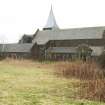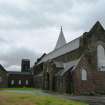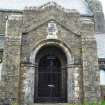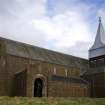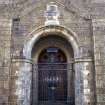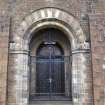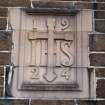Ordnance Survey licence number AC0000807262. All rights reserved. © Copyright and database right 2024.
Useful Links
- Canmore:
- DECHMONT, BANGOUR VILLAGE HOSPITAL, CHURCH
- Historic Scotland:
- HS Reference No 51902
General Details and Location
Category
AT RISK
Name of Building
Bangour Village Hospital: Church
Other Name(s)
Edinburgh District Asylum (Former); Edinburgh War Hospital (Former)
Address
Bangour Village, Dechmont
Locality
Postcode
Planning Authority
Divisional Area
Reference No
3431
Listing Category
A
OS Grid Ref
NT 03188 71042
Location Type
Rural Settlement
HS Reference No
51902
Description
7-bay nave and lower aisle asymmetrical neo-Romanesque church with square-plan tower with broach leaded spire to SE, apsed memorial chapel to S and lower gabled choir and vestry rooms to N with shallow gabled tower to NE. Situated on prominent raised location at centre of colony planned village hospital site. Roughly squared and snecked brown whinstone with polychrome window arch stones and margins. Clerestorey, cornice. Round-arched windows.
The church is an outstanding and well detailed building situated on an elevated position at the centre of the Bangour Village Hospital site. It is a key component of the village concept of the hospital as envisaged by the original architect of the scheme, Hippolyte J Blanc, and is noted by McWilliam (see above) to be the grandest 20th century church in the Lothians. It is largely unaltered both externally and internally. Built in a Romanesque style, with Continental influence in the low, squat broached spire and contrasting materials, the church is in a different architectural style to the rest of the hospital and was intended from the beginning to allow for all forms of Christian worship. A church was always planned to be included in the hospital site, but was not realised until this one was built as a memorial for the contribution Bangour had made to the war. The church was dedicated in 1930. All the work was carried out by the Clerk of Works to the Hospital, William Livingstone and some of the interior woodwork was completed by patients resident at the hospital. The external whinstone is from a local quarry and the interior sandstone was brought from the dismantling of Hamilton Palace. The church was dedicated to Our Lady and has the Monogram MR (Maria Regina) on the piers a the W end. A plaque in the tympanum of the porch to the south reads: friend, this house of God stands open for thee ever that thou mayest enter rest think kneel and pray remember whence thou art and what must be thine end remember us then go thy way.
Designed in a restrained Scots Renaissance style, Bangour Village Hospital is an outstanding remaining example of a psychiatric hospital built as a village and espousing a complete philosophy of care. The village system of patient care, exemplified by the Alt-Scherbitz hospital, near Leipzig in Germany in the 1870s encouraged psychiatric patients to be cared for within their own community setting, where there were few physical restrictions and where village self-sufficiency was encouraged. This was in contrast to the large contemporary asylum buildings. This philosophy had been gradually developing in a number of Scottish institutions, but Bangour saw its apotheosis, specifically in relation to psychiatric patients. Two other hospitals were built in Scotland for psychiatric patients, Kingseat, to the north of Aberdeen (built in 1904) and Dykebar Hospital in Paisley, 1909 (see separate listing). These have not survived as completely as Bangour.
The hospital was built by the well-known Edinburgh architect Hippolyte J Blanc as a result of a competition begun in 1898. The Edinburgh Lunacy Board had concluded that a new psychiatric hospital was required to cater for the increasing numbers of patients from Edinburgh and the hospital was opened in 1906, with some of the buildings still to be completed. It was designed with no external walls or gates. The utility buildings were positioned at the centre of the site, the medical buildings for patients requiring medical supervision and treatment were to the E and there were villas to the W of the site which could accommodate patients who required less supervision and were able to work at some sort of industry. The complex also included a farm to the NW (not part of current site) and had its own water and electricity systems and also had its own railway. The hospital was commissioned by the War Office in WWI for wounded soldiers and extra temporary structures were erected. Most of these were dismantled after the War although some timber ones were retained by the hospital. The railway too was dismantled in 1921. The patients returned in 1922. The hospital was commissioned again for WWII. At this time many temporary shelters were erected to the NW of the site and this became the basis of the Bangour General Hospital (now demolished). Bangour Village Hospital continued as a psychiatric hospital until 2004.
Harold O Tarbolton (1869-1947) was born in Nottingham and came to work in Edinburgh in the 1890s. He was involved in designing a variety of building types, including a number of Episcopal Churches throughout Scotland. He was consulting architect to the Deans and Chapters of the Cathedrals in Perth and Oban (see separate listings) and became the advisory architect for the North of Scotland Hydro Electric Board in 1944. He was a prominent figure in public life in Edinburgh.
List description updated following review, 2012. The Memorial Church was formerly listed at category A as part of a single listing covering Bangour Village Hospital. (Historic Scotland)
The church is an outstanding and well detailed building situated on an elevated position at the centre of the Bangour Village Hospital site. It is a key component of the village concept of the hospital as envisaged by the original architect of the scheme, Hippolyte J Blanc, and is noted by McWilliam (see above) to be the grandest 20th century church in the Lothians. It is largely unaltered both externally and internally. Built in a Romanesque style, with Continental influence in the low, squat broached spire and contrasting materials, the church is in a different architectural style to the rest of the hospital and was intended from the beginning to allow for all forms of Christian worship. A church was always planned to be included in the hospital site, but was not realised until this one was built as a memorial for the contribution Bangour had made to the war. The church was dedicated in 1930. All the work was carried out by the Clerk of Works to the Hospital, William Livingstone and some of the interior woodwork was completed by patients resident at the hospital. The external whinstone is from a local quarry and the interior sandstone was brought from the dismantling of Hamilton Palace. The church was dedicated to Our Lady and has the Monogram MR (Maria Regina) on the piers a the W end. A plaque in the tympanum of the porch to the south reads: friend, this house of God stands open for thee ever that thou mayest enter rest think kneel and pray remember whence thou art and what must be thine end remember us then go thy way.
Designed in a restrained Scots Renaissance style, Bangour Village Hospital is an outstanding remaining example of a psychiatric hospital built as a village and espousing a complete philosophy of care. The village system of patient care, exemplified by the Alt-Scherbitz hospital, near Leipzig in Germany in the 1870s encouraged psychiatric patients to be cared for within their own community setting, where there were few physical restrictions and where village self-sufficiency was encouraged. This was in contrast to the large contemporary asylum buildings. This philosophy had been gradually developing in a number of Scottish institutions, but Bangour saw its apotheosis, specifically in relation to psychiatric patients. Two other hospitals were built in Scotland for psychiatric patients, Kingseat, to the north of Aberdeen (built in 1904) and Dykebar Hospital in Paisley, 1909 (see separate listing). These have not survived as completely as Bangour.
The hospital was built by the well-known Edinburgh architect Hippolyte J Blanc as a result of a competition begun in 1898. The Edinburgh Lunacy Board had concluded that a new psychiatric hospital was required to cater for the increasing numbers of patients from Edinburgh and the hospital was opened in 1906, with some of the buildings still to be completed. It was designed with no external walls or gates. The utility buildings were positioned at the centre of the site, the medical buildings for patients requiring medical supervision and treatment were to the E and there were villas to the W of the site which could accommodate patients who required less supervision and were able to work at some sort of industry. The complex also included a farm to the NW (not part of current site) and had its own water and electricity systems and also had its own railway. The hospital was commissioned by the War Office in WWI for wounded soldiers and extra temporary structures were erected. Most of these were dismantled after the War although some timber ones were retained by the hospital. The railway too was dismantled in 1921. The patients returned in 1922. The hospital was commissioned again for WWII. At this time many temporary shelters were erected to the NW of the site and this became the basis of the Bangour General Hospital (now demolished). Bangour Village Hospital continued as a psychiatric hospital until 2004.
Harold O Tarbolton (1869-1947) was born in Nottingham and came to work in Edinburgh in the 1890s. He was involved in designing a variety of building types, including a number of Episcopal Churches throughout Scotland. He was consulting architect to the Deans and Chapters of the Cathedrals in Perth and Oban (see separate listings) and became the advisory architect for the North of Scotland Hydro Electric Board in 1944. He was a prominent figure in public life in Edinburgh.
List description updated following review, 2012. The Memorial Church was formerly listed at category A as part of a single listing covering Bangour Village Hospital. (Historic Scotland)
Building Dates
Dated 1924, completed 1930
Architects
Harold O. Tarbolton
Category of Risk and Development History
Condition
Fair
Category of Risk
Low
Exemptions to State of Risk
Field Visits
December 1992, February 2000, January 2002, 11/04/2008, 06/08/2010, 13/4/2015
Development History
December 1992: 10 January 1992: The Lothian Courier reports that Broxburn Community Council has asked local planners to place a Buildings Preservation Notice on the administration blocks, in order to preserve them for the future. It is now Health Board policy to concentrate resources on buildings to the centre of the complex, with those on the periphery being gradually wound down.
December 1992: External inspection shows some villas to be unused and boarded-up. The remainder of the complex is operational and appears in good order.
August 1995: SCT receives information that West Lothian Health Care Trust has appointed Edinvar Consultants to assess future options for the site.
October 1995: The draft report suggests the formation of a village community, with shops, housing, offices and leisure facilities.
January 1997: An outline planning application is lodged for the conversion and redevelopment of the hospital buildings. SCT commends the considered nature of these outline proposals.
March 1998: SCT receives information that Outline Planning Permission is being held in abeyance due to the rehousing of patients, although the whole site is gradually being wound down. There is cause for growing concern over the state of several more of the listed buildings, now unoccupied.
22 July 1999: The West Lothian Courier reports on plans to develop the site into a housing, hotel, golf course and conference centre complex, when the hospital closes at the end of 2000. It is reported that the plans have been discussed by West Lothian Council‘s Strategic Services Committee, although no decision has been taken, pending further discussions with Dechmont Community Council. 200 patients remain in the hospital.
5 August 1999: The West Lothian Herald and Post reports that the Strategic Services Committee has again discussed the proposals. A new-build of 200 homes, coupled with the conversion of the existing buildings and the maintenance of the church, is said to have gained favour, although local residents are to be invited to express their views.
February 2000: Local planners report that West Lothian Healthcare Trust is testing the market for the site. West Lothian Council has prepared a brief for its redevelopment.
November 2000: SCT receives information that WLHCT is considering purchase bids.
December 2002: Local planners report that a preferred bidder has been identified and an outline planning application is probably imminent. There is concern at the adaptability of the Recreation Hall and Church in particular, and their ability to be integrated into any development proposals. The former is reported to still be used for meetings.
December 2004: Outline Planning Permission is now being sought.
December 2004: The Architectural Heritage Fund reports that the Scottish Redundant Churches Trust has conducted a feasibility study into new uses for the church. The study identified viable uses but failed to determine sufficient sources of funding. SRCT is now in discussions with the developer of the site over the future of the church.
5 March 2005: The Edinburgh Evening News reports on the filming of the latest George Clooney film at the hospital.
1 May 2005: Scotland on Sunday reports on the filming of the latest George Clooney film at the hospital.
September 2006: local planning authority report that the application still remains undetermined.
December 1992: External inspection shows some villas to be unused and boarded-up. The remainder of the complex is operational and appears in good order.
August 1995: SCT receives information that West Lothian Health Care Trust has appointed Edinvar Consultants to assess future options for the site.
October 1995: The draft report suggests the formation of a village community, with shops, housing, offices and leisure facilities.
January 1997: An outline planning application is lodged for the conversion and redevelopment of the hospital buildings. SCT commends the considered nature of these outline proposals.
March 1998: SCT receives information that Outline Planning Permission is being held in abeyance due to the rehousing of patients, although the whole site is gradually being wound down. There is cause for growing concern over the state of several more of the listed buildings, now unoccupied.
22 July 1999: The West Lothian Courier reports on plans to develop the site into a housing, hotel, golf course and conference centre complex, when the hospital closes at the end of 2000. It is reported that the plans have been discussed by West Lothian Council‘s Strategic Services Committee, although no decision has been taken, pending further discussions with Dechmont Community Council. 200 patients remain in the hospital.
5 August 1999: The West Lothian Herald and Post reports that the Strategic Services Committee has again discussed the proposals. A new-build of 200 homes, coupled with the conversion of the existing buildings and the maintenance of the church, is said to have gained favour, although local residents are to be invited to express their views.
February 2000: Local planners report that West Lothian Healthcare Trust is testing the market for the site. West Lothian Council has prepared a brief for its redevelopment.
November 2000: SCT receives information that WLHCT is considering purchase bids.
December 2002: Local planners report that a preferred bidder has been identified and an outline planning application is probably imminent. There is concern at the adaptability of the Recreation Hall and Church in particular, and their ability to be integrated into any development proposals. The former is reported to still be used for meetings.
December 2004: Outline Planning Permission is now being sought.
December 2004: The Architectural Heritage Fund reports that the Scottish Redundant Churches Trust has conducted a feasibility study into new uses for the church. The study identified viable uses but failed to determine sufficient sources of funding. SRCT is now in discussions with the developer of the site over the future of the church.
5 March 2005: The Edinburgh Evening News reports on the filming of the latest George Clooney film at the hospital.
1 May 2005: Scotland on Sunday reports on the filming of the latest George Clooney film at the hospital.
September 2006: local planning authority report that the application still remains undetermined.
April 2008: External inspection finds the building remains derelict but in fair condition. The walls are stained in many places by a white residue leeching out of the pointing indicating that the walls are saturated in parts.
March 2009: SCT is contacted by a member of the public who advises that the church has now been fitted with metal window grills.
August 2010: External inspection finds the building remains derelict. There is no evidence of maintenance. Outwardly, it appears to be in fair condition. Many original windows have been broken through the installation of protective metal grills. Plants are gaining a foothold on the walls. Outline planning permission for development of the former hospital site, ref: 1120/P/04, has been withdrawn. Local planners advise the former hospital owner's planning consultants are working on a revised masterplan for the overall site. Regular meetings between the site owners and the local authority continue
3 October 2012: Local planners advise Historic Scotland has re-surveyed the former hospital site. Some buildings have changed listing category and some buildings are newly listed. The former church remains A-listed.
15 January 2015: STV News website reports NHS Lothian has engaged GVA James Barr to draw up proposals for the conversion of the former hospital to form housing, to aid marketing of the site for sale, with a view to submitting Full Planning Permission later this year.
13 April 2015: External inspection finds the building remained in much the same condition as seen previously. The former church appears well secured.
Proposal of Application Notice for the redevelopment of the former hospital site was lodged with West Lothian Council in Jan 2015 ref: LIVE/0058/PAC/15. The complex is being marketed for sale through agents DTZ, with a dedicated website for interested parties at www.bangourvillage.co.uk.
Proposal of Application Notice for the redevelopment of the former hospital site was lodged with West Lothian Council in Jan 2015 ref: LIVE/0058/PAC/15. The complex is being marketed for sale through agents DTZ, with a dedicated website for interested parties at www.bangourvillage.co.uk.
1 October 2015: Planning Permission in Principle for a residential and mixed use redevelopment of the former hospital site is being sought ref:LIVE/0607/P/15. The application notes some of the listed buildings at the site may be proposed for full demolition in a subsequent application. This may include villas 7,8,9 and 21, with other buildings potentially proposed for partial demolition.
23 March 2016: A member of the public advises stained glass to a gable wall is buckling.
17 March 2023: Planning permission has been granted in principle for a 90ha residential development with retail facilities, food and drink, community, education, assembly and leisure, non-residential institution uses and associated infrastructure (with Environmental Impact Assessment) (1019/P/19)
As part of this plan it is proposed that the Church is retained, with the intention to change the use to a community building.
As part of this plan it is proposed that the Church is retained, with the intention to change the use to a community building.
Guides to Development
Conservation Area
Bangour Village
PAC Telephone Number
Availability
Current Availability
Not Available
Appointed Agents
Price
Occupancy
Vacant
Occupancy Type
N/A
Present/Former Uses
Name of Owners
Lothian NHS
Type of Ownership
Health Authority/Trust
Information Services
Additional Contacts/Information Source
1914-1918 The Long, Long Trail http://www.1914-1918.net/bangourwarhospital.html
Bibliography
Hendrie and Macleod (1991); Jaques and McKean (1994), pp66-67; McWilliam (1978), pp90-92; Richardson; Academy Architecture, (1) 1899, pp88, 94; The Builder, 13 August 1898, p153; Edinburgh Medical Journal, March 1916; Journal of the Royal Institute of British Architects, (15), March 1908, p309 and 10 November 1906, p545.
Online Resources
Classification
Churches and Chapels
Original Entry Date
19-MAY-08
Date of Last Edit
11/02/2020



